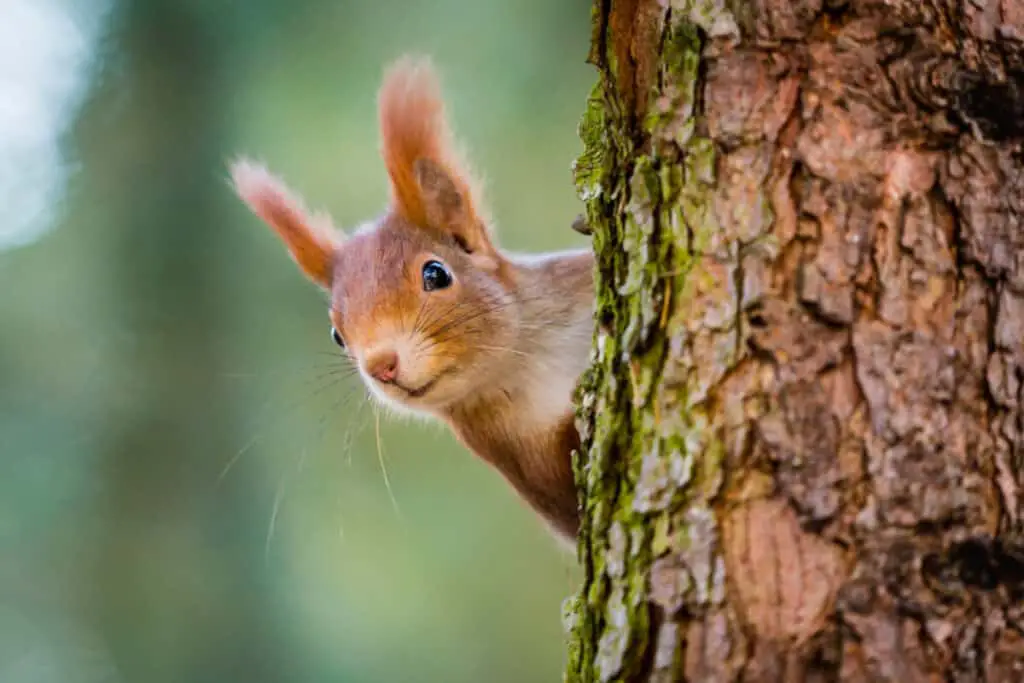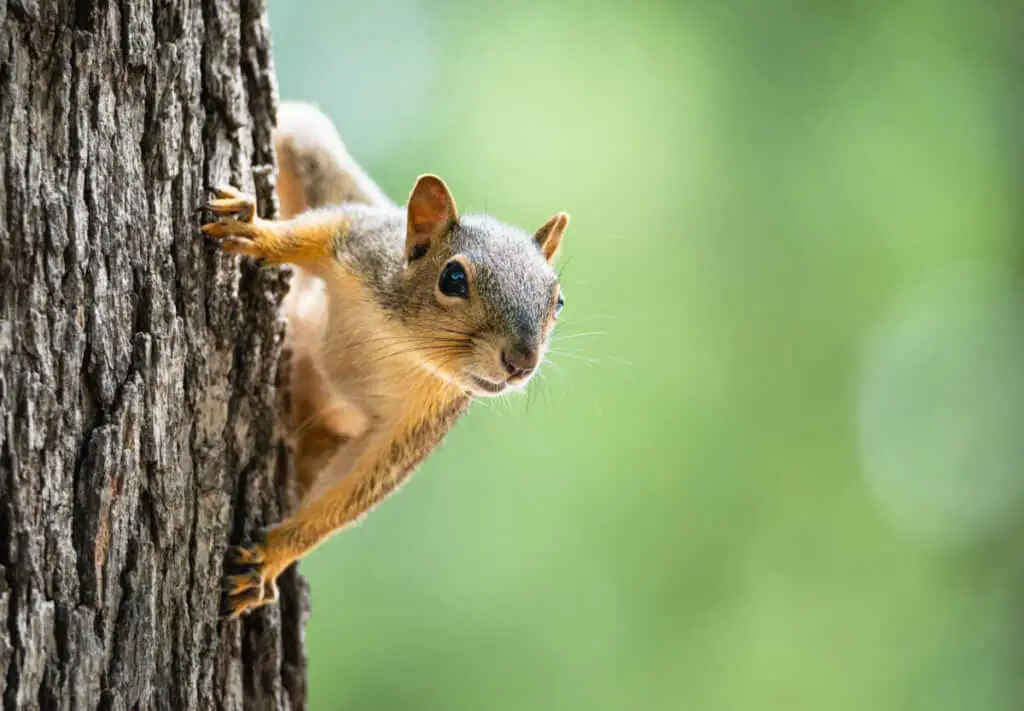Squirrels are a common sight in many parts of the world, inhabiting forests, parks, and even urban areas. These small mammals belong to the family Sciuridae and are known for their bushy tails and characteristic habit of storing food for winter months.
In North America alone, there are over 200 species of squirrels, making them one of the most diverse groups of mammals on the continent.
Despite being widely recognized as cute and charismatic creatures, squirrels can have significant impacts on human activities. They are often considered pests due to their tendency to raid bird feeders or chew through electrical wires, causing damage to homes and infrastructure.
However, squirrels also play important ecological roles as seed dispersers and prey for larger predators such as hawks and owls.
Understanding the behavior and ecology of these animals is crucial for managing conflicts with humans while preserving their role in natural ecosystems.

Classification And Diversity Of Squirrels
The squirrel is a well-known member of the rodent family. Its evolutionary history dates back to over 40 million years ago when it first appeared in Eurasia during the Eocene epoch.
Since then, squirrels have evolved into more than 200 species that inhabit various regions around the world. Geographical distribution plays a significant role in the classification and diversity of squirrels.
Squirrels can be found on every continent except for Australia and Antarctica. They are most diverse in tropical rainforests but also live in temperate forests, deserts, grasslands, and urban areas.
The different environments where squirrels thrive have influenced their physical characteristics such as body size, fur coloration, and tail shape. For example, flying squirrels have flaps of skin called patagia that help them glide through forested areas while ground-dwelling squirrels like prairie dogs have longer limbs and claws adapted for digging burrows.
Anatomy And Adaptations For Survival
Squirrels are small rodents that have adapted to survive in various environments. They have physical features that enable them to climb trees, burrow underground, and jump from branch to branch. Their agility is due to their long, bushy tails that help with balance and stability when running or leaping through the air. Additionally, squirrels possess sharp claws that allow them to grip onto surfaces such as tree bark or soil. These physical traits make it easier for squirrels to evade predators quickly.
In addition to their physical characteristics, squirrels also display unique behavioral patterns that aid in survival. For instance, they hoard food during the fall months to prepare for winter hibernation. Squirrels bury nuts and seeds in various locations around their habitat so they will always have a source of nutrition throughout the colder season.
Furthermore, some species of squirrels emit vocalizations as a means of communication with other members of their group. These behaviors ensure a squirrel’s survival by providing sustenance and protection within social structures.
Squirrels also display territorial behavior to protect their resources and offspring. They are known to communicate with each other through scent marking and vocalizations. Social Structures involve communal nesting and cooperative care of young.
Diet And Foraging Behavior
Nutritional needs of squirrels vary depending on the season and their activity level. During periods of high activity, such as in the spring when they are mating or in the fall when they are gathering food for winter, squirrels require a higher calorie intake than during periods of rest.
Their diet consists primarily of nuts, seeds, fruits, insects and fungi. They also occasionally consume small vertebrates like frogs and birds. Squirrels have been observed to prefer certain foods over others. For example, some species tend to favor acorns while others prefer hickory nuts. Preferences may even differ within populations based on availability of food sources.
Squirrels will often store excess food in underground caches to eat later during times when food is scarce. This behavior not only helps them survive harsh winters but it also aids in seed dispersal which contributes to forest regeneration.
Interactions With Humans And Ecological Impacts
Human interaction with squirrels has been a common occurrence due to the adaptability of these animals. Squirrels are often found in urban areas and have adapted well to human environments, which can result in frequent interactions between humans and these rodents.
While some people find them endearing, others view them as pests that cause damage to property or harm other wildlife.
The expansion of urbanization and habitat destruction has resulted in significant impacts on squirrel populations. The loss of natural habitats such as forests and woodlands has led many species to move into more urbanized areas. This shift towards an increasingly urban environment exposes them to new threats from predators, parasites, diseases, and pollutants.
Moreover, it may lead to increased competition for resources among different animal populations living within cities. Therefore, understanding how human interactions affect squirrel populations is important for creating effective conservation strategies that ensure their survival in the long term.
Conservation And Management Strategies
Interactions with humans have had a profound impact on the squirrel population.
Habitat destruction, caused by urbanization and deforestation, has been one of the major reasons for the decline in their numbers.
Human development activities like construction, mining, and agriculture have led to the clearing of forests at an alarming rate.
The loss of habitat has resulted in reduced food availability and shelter options for squirrels.
As a result, they are forced to migrate or adapt to new environments that may not be suitable for their survival.
Furthermore, human activities such as hunting and trapping pose additional threats to squirrel populations.
The combination of these factors has led to significant declines in squirrel populations across many regions.
Fascinating Facts About Squirrels
It is ironic how the squirrel, often seen as a cute and harmless creature, can be quite mischievous in reality. Known for their infamous habit of stealing bird seeds from feeders, squirrels have been caught red-handed on numerous occasions. Despite this, they remain one of the most beloved animals due to their cute demeanor and playful antics.
One fascinating fact about squirrels is that they are avid nut hoarders and scatterers. They bury nuts underground during autumn as a way to prepare for the winter months when food may be scarce. However, studies show that squirrels do not always retrieve these hidden treasures, resulting in new trees sprouting up where they were least expected.
This behavior plays an essential role in maintaining forest diversity by dispersing seeds throughout different areas. In conclusion, it’s evident that while squirrels may seem like innocent creatures on the surface, there’s much more than meets the eye when it comes to these nut hoarding and scatterer rodents.

Conclusion
Squirrels are small, agile rodents belonging to the family Sciuridae. They are found in various habitats across the world and display remarkable diversity in their physical characteristics and behavioral adaptations. Squirrels have sharp claws, strong jaws, and long tails that give them exceptional balance and agility while climbing trees or leaping from branch to branch.
Their diet consists mainly of nuts, seeds, fruits, insects, and sometimes even bird eggs. Despite being cute and furry creatures loved by many people worldwide, squirrels can cause significant damage to crops and gardens if not managed properly. Therefore, it is essential to understand their ecological impacts on different ecosystems, especially urban environments where they often interact with humans.
The conservation of squirrel populations is also crucial as they play an important role in seed dispersal and forest regeneration. In conclusion, squirrels are fascinating animals that exhibit unique behaviors and adaptations for survival. From their impressive acrobatic skills to their diverse diets and interactions with humans, these little critters continue to capture our attention through popular culture references such as ‘Rocky’ from Rocky & Bullwinkle or Scrat from the Ice Age franchise.
Through proper management strategies such as responsible feeding practices or wildlife rehabilitation programs when necessary we can ensure the continued success of this beloved animal symbol of resilience amidst adversity.

